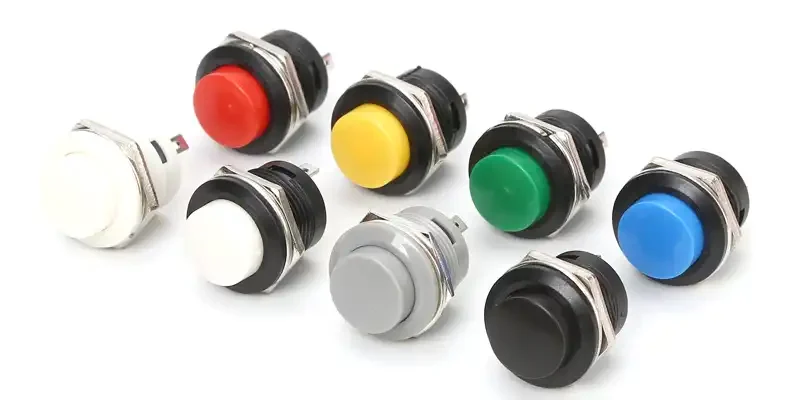Що таке кнопковий вимикач?
Кнопковий вимикач - це універсальний електричний пристрій, який керує струмом у ланцюзі простим натисканням. Поширені в будинках, на робочих місцях і в різних середовищах, ці вимикачі є важливими компонентами в сучасних електронних і механічних системах. Зазвичай виготовлені з пластику або металу, кнопки можуть бути пласкими або ергономічної форми для зручності використання. При натисканні вони замикають ланцюг, пропускаючи струм. Кнопкові вимикачі бувають різних типів, включаючи миттєві, фіксуючі та з підсвічуванням, кожен з яких виконує різні функції. Вони працюють за допомогою базового електричного або пневматичного механізму перемикання і можуть бути миттєвими або фіксуючими. Ці перемикачі необхідні для ефективного керування в різних сферах застосування - від побутових приладів до складного промислового обладнання, пропонуючи інтуїтивно зрозумілий і надійний спосіб активації або деактивації функцій.
Будова кнопкового вимикача
Кнопковий вимикач, як правило, складається з ковпачка кнопки, поворотної пружини, рухомого контакту мостового типу, статичного контакту, шатуна і корпусу.
Принцип роботи
- Приведення в дію: При натисканні на кнопку спрацьовує внутрішній механізм, який зазвичай складається з пружини та електричних контактів. Тиск, прикладений до кнопки, стискає пружину і переміщує внутрішні контакти в положення, в якому вони або з'єднуються, або роз'єднуються, залежно від типу вимикача.
- Типи контактів:
- Нормально відкритий (NO): У цій конфігурації ланцюг розімкнутий, коли кнопка не натиснута. Натискання кнопки замикає коло, дозволяючи струму протікати. Це типовий випадок для таких застосувань, як дверні дзвінки та миттєві вимикачі.
- Нормально замкнений (NC): У цьому випадку ланцюг замкнутий, коли кнопка не натиснута. Натискання кнопки розмикає коло, перериваючи потік струму. Цей тип часто використовується в системах безпеки, наприклад, у кнопках аварійної зупинки.
- Механізм повернення: Після відпускання кнопки пружинний механізм повертає її у вихідне положення. Ця дія повертає ланцюг у попередній стан - розімкнутий або замкнутий - залежно від того, чи це був замикаючий або розмикаючий перемикач.
Перегляньте відео про те, як працює кнопка
Типи кнопкових вимикачів
Кнопкові вимикачі бувають різних типів, які класифікуються за різними характеристиками:
Типи, засновані на формі:
- Квадратний: Ці вимикачі мають велику кнопку або актуатор квадратної форми. Велика площа поверхні робить їх популярними в промисловому застосуванні.
- Круглі: Круглі кнопкові вимикачі, що характеризуються круглою формою і компактними розмірами, часто зустрічаються в побутовій техніці та споживчій електроніці завдяки своєму ергономічному дизайну і довговічності.
Типи на основі конфігурації:
- Однополюсний з одним кидком (SPST): Найпоширеніший тип, що має один полюс і один перемикач. Ці вимикачі зазвичай використовуються для відключення або повторного підключення одного провідника в одному відгалуженні ланцюга.
- Однополюсні подвійні перемикачі (SPDT): Ці перемикачі мають один полюс і два перемикачі або вихідні клеми, що дозволяє керувати кількома ланцюгами, вибираючи один з двох станів виходу.
Типи, засновані на функціональності:
- Миттєві вимикачі: Залишаються активними лише доти, доки натиснута кнопка. При відпусканні ланцюг розривається, перериваючи потік струму. Поширеними прикладами є дверні дзвінки та зумери.
- Перемикачі з фіксацією: Ці перемикачі зберігають своє положення після натискання до наступної активації. Одноразове натискання на кнопку змінює стан вимикача, який зберігається до наступного натискання. Типовим прикладом такого вимикача є звичайний вимикач у будинку.
Номінальні значення напруги кнопкового вимикача
Кнопкові вимикачі доступні з різними номінальними значеннями напруги, що має вирішальне значення для їхньої придатності для різних застосувань. Розуміння цих номіналів необхідне для правильного вибору та безпечної експлуатації.
Номінали загальної напруги:
- Низька напруга: Багато вимикачів розраховані на напругу до 32 В постійного струму, що ідеально підходить для низьковольтних застосувань.
- Стандартний діапазон: Типові номінальні значення коливаються від 12 В постійного струму до 250 В змінного струму, залежно від конструкції та використання.
- Конкретні приклади: Деякі миттєві вимикачі витримують 5 мА при 32 В постійного струму, тоді як інші розраховані на 3 А при 125 В змінного струму або 1,5 А при 250 В змінного струму.
Міркування щодо змінного та постійного струму:
- Різні номінали: Перемикачі змінного та постійного струму часто мають різні номінальні значення напруги через різні характеристики протікання струму.
- Сумісність ланцюгів: Дуже важливо вибрати вимикач, призначений для ланцюгів змінного або постійного струму відповідно до застосування.
Навантаження та фактори навколишнього середовища:
- Тип навантаження: Резистивні та індуктивні навантаження по-різному впливають на номінальну напругу. Для індуктивних навантажень можуть знадобитися вимикачі з більш високим пусковим струмом.
- Захист навколишнього середовища: Деякі вимикачі мають додатковий клас захисту (наприклад, IP67) від пилу та води, що дуже важливо для зовнішнього або промислового використання.
Рекомендації щодо відбору:
- Технічні характеристики виробника: Завжди звертайтеся до технічного паспорту виробника для отримання точних номінальних значень напруги та струму.
- Залежно від застосування: Враховуйте передбачуване використання, оскільки номінальні характеристики можуть сильно відрізнятися між мініатюрними та промисловими моделями.
Як вибрати кнопковий перемикач?
Кнопкові вимикачі - це універсальні компоненти, які потребують належного розуміння для ефективного використання та обслуговування. Щоб правильно їх використовувати, визначте тип вимикача (миттєвий або фіксуючий) і встановіть його відповідно до специфікацій виробника, забезпечивши належне підключення та відповідні номінальні значення напруги. Використовуйте вимикач за призначенням: безперервним натисканням для миттєвих вимикачів або однократним натисканням для вимикачів з фіксацією.
Як користуватися та обслуговувати кнопкові вимикачі?
Для обслуговування регулярно очищайте поверхню перемикача, оглядайте електричні з'єднання та перевіряйте їх на наявність фізичних пошкоджень. Періодично перевіряйте функціональність і враховуйте фактори навколишнього середовища, які можуть вплинути на продуктивність. За необхідності замініть компоненти або весь комутатор, і завжди тримайте документацію під рукою для довідок. Дотримуючись цих рекомендацій, користувачі можуть забезпечити оптимальну продуктивність і довговічність своїх кнопкових перемикачів у різних сферах застосування.
Виробники кнопок
| Назва компанії | Знайдено Рік | Країна | WEB |
|---|---|---|---|
| Schneider Electric | 1836 | Франція | Schneider.com |
| Electro-Mech Components, Inc. (EMC) | 1966 | США | electromechcomp.com |
| Силові вимикачі та реле Electroswitch | 1946 | США | Electroswitch.com |
| Корпорація OMRON | 1933 | Японія | OMRON.com |
| ЧИНТ | 1994 | Китай | Chint.com |
| ABB Limited | 1883 | Швейцарія | ABB.com |
| Eaton Corporation Inc. | 1911 | США | Eaton.com |
| Toshiba Corporation | 1875 | Японія | Toshiba.com |




